【Java】Mybatis 学习整理
= = = = = = = = = = = = = = = = = THE BEGIN = = = = = = = = = = = = = = = = = = = = =
我的运行环境
- JDK 1.8
- Mysql 5.7
- maven 3.6.3
- IDEA
参考网站:mybatis 中文网
简介
什么是 MyBatis?
MyBatis 是一款优秀的持久层框架,它支持自定义 SQL、存储过程以及高级映射。MyBatis 免除了几乎所有的 JDBC 代码以及设置参数和获取结果集的工作。MyBatis 可以通过简单的 XML 或注解来配置和映射原始类型、接口和 Java POJO(Plain Old Java Objects,普通老式 Java 对象)为数据库中的记录。
如何获得 mybatis?
maven 仓库:
<!-- https://mvnrepository.com/artifact/org.mybatis/mybatis -->
<dependency>
<groupid>org.mybatis</groupid>
<artifactid>mybatis</artifactid>
<version>3.5.6</version>
</dependency>
Github 地址:<https: github.com="" mybatis="" mybatis-3="" releases="" tag="" mybatis-3.5.7="">
中文文档:<https: mybatis.org="" mybatis-3="" zh="" index.html="">(貌似有时打不开)或<https: mybatis.net.cn="" index.html="">
持久化
数据持久化
- 持久化就是将程序的数据在持久状态和瞬时状态转化的过程
- 内存:断电即失
- 数据库(JDBC),io 文件持久化
- 生活:冷藏
持久层
Dao 层,Service 层,Controller 层 ……
- 完成持久层工作的代码块
- 层界限十分明显
为什么需要 MyBatis?
-
帮助程序员将数据存入到数据库中
-
方便
-
传统的 JDBC 代码太复杂。mybatis 可以简化,框架自动化
-
优点:
- 简单易学
- 灵活:mybatis 不会对应用程序或者数据库的现有设计强加任何影响。 sql 写在 xml 里,便于统一管理和优化。通过 sql 语句可以满足操作数据库的所有需求。
- 解除 sql 与程序代码的耦合:通过提供 DAO 层,将业务逻辑和数据访问逻辑分离,使系统的设计更清晰,更易维护,更易单元测试。sql 和代码的分离,提高了可维护性。
- 提供映射标签,支持对象与数据库的 orm 字段关系映射
- 提供对象关系映射标签,支持对象关系组建维护
- 提供 xml 标签,支持编写动态 sql
最重要的一点:使用的人多
第一个 Mybatis 程序
思路:搭建环境 ==> 导入 Mybatis ==> 编写代码 ==> 测试
搭建环境
搭建数据库:
CREATE DATABASE mybatis;
USE mybatis;
CREATE TABLE user (
id INT(20) NOT NULL PRIMARY KEY,
name VARCHAR(30) DEFAULT NULL,
pwd VARCHAR(30) DEFAULT NULL
)ENGINE=INNODB DEFAULT CHARSET=utf8;
INSERT INTO user(id, name, pwd) VALUES
(1, 'hhh', '123456'),
(2, '张三', '123456'),
(3, '李四', '123654');
新建项目:
-
新建一个普通的 maven 项目
-
删除 src 目录
-
打入 maven 依赖
<dependencies> <!--mysql 驱动--> <dependency> <groupid>mysql</groupid> <artifactid>mysql-connector-java</artifactid> <version>5.1.47</version> </dependency> <!--mybatis--> <!-- https://mvnrepository.com/artifact/org.mybatis/mybatis --> <dependency> <groupid>org.mybatis</groupid> <artifactid>mybatis</artifactid> <version>3.5.6</version> </dependency> <dependency> <groupid>junit</groupid> <artifactid>junit</artifactid> <version>4.11</version> </dependency> </dependencies>
创建一个模块
- 编写 mybatis 的核心配置文件
<environments default="development">
<environment id="development">
<transactionmanager type="JDBC">
<datasource type="POOLED">
<property name="driver" value="com.mysql.jdbc.Driver">
<property name="url" value="jdbc:mysql://localhost:3306/mybatis?useSSL=true&useUnicode=true&characterEncoding=UTF-8">
<property name="username" value="root">
<property name="password" value="h020809.">
</property></property></property></property></datasource>
</transactionmanager></environment>
</environments>
- 编写 mybatis 工具类
package org.example.utils;
import org.apache.ibatis.io.Resources;
import org.apache.ibatis.session.SqlSession;
import org.apache.ibatis.session.SqlSessionFactory;
import org.apache.ibatis.session.SqlSessionFactoryBuilder;
import java.io.IOException;
import java.io.InputStream;
/**
* SqlSessionFactory:构建 SqlSession
*/
public class MybatisUtils {
private static SqlSessionFactory sqlSessionFactory;
static {
try {
// 使用 Mybatis 第一步:获取 SqlSessionFactory 对象
String resource = "mybatis-config.xml";
InputStream inputStream = Resources.getResourceAsStream(resource);
sqlSessionFactory = new SqlSessionFactoryBuilder().build(inputStream);
} catch (IOException e) {
e.printStackTrace();
}
}
/**
* 从 SqlSessionFactory 中获取 SqlSession:
*
* 既然有了 SqlSessionFactory,顾名思义,我们可以从中获得 SqlSession 的实例。
* SqlSession 提供了在数据库执行 SQL 命令所需的所有方法。你可以通过 SqlSession 实例来直接执行已映射的 SQL 语句。
*/
public static SqlSession getSqlSession() {
return sqlSessionFactory.openSession();
}
}
编写代码
-
实体类
-
Dao 接口
public interface UserDao { List<user> getUserList(); } -
接口实现类由原来的 UserDaoImpl 转变为一个 Mapper 配置文件
<!--?xml version="1.0" encoding="UTF-8" ?--> <!--namespace:绑定一个对应的 Dao/Mapper 接口--> <mapper namespace="org.example.dao.UserDao"> <select id="getUserList" resulttype="org.example.pojo.User"> select * from mybatis.user </select> </mapper>
测试
注意点:org.apache.ibatis.binding.BindingException: Type interface org.example.dao.UserDao is not known to the MapperRegistry.
<!--每一个 Mapper.xml 都需要在 Mybatis 核心配置文件中注册!-->
Juint 测试
public class UserDaoTest {
@Test
public void test() {
// 第一步:获得 SqlSession 对象
SqlSession sqlSession = MybatisUtils.getSqlSession();
// 方式一:getMapper
UserDao userMapper = sqlSession.getMapper(UserDao.class);
List<user> userList = userMapper.getUserList();
for (User user : userList) {
System.out.println(user);
}
// 关闭 SqlSession
sqlSession.close();
}
}
可能会遇到的问题:
- 配置文件没有注册
- 绑定接口错误
- 方法名不对
- 返回类型不对
- Maven 导出资源问题
小结
第一步、先写工具类 MybatisUtils,获取 sqlSessionFactory 对象,这需要用到 "mybatis-config.xml" 文件
第二步、写 "mybatis-config.xml" 配置文件
第三步、写实体类 User
第四步、(1)写操作接口 UserDao(或 UserMapper),(2)并写 UserMapper.xml 文件实现该接口
第五步、进行测试


CRUD
namespace
namespace 中的包名要和 Dao/Mapper 接口的包名一致。
select
选择,查询语句;
- id:就是对应的 namespace 中的方法名
- resultType:Sql 语句执行的返回值
- parameterType:参数类型
步骤:
-
编写接口
User getUserById(int id); // 根据 id 查询用户 -
编写对应的 mapper 中的 sql 语句
<!--对象中的属性,可以直接取出来--> <select id="getUserById" parametertype="int" resulttype="org.example.pojo.User"> select * from mybatis.user where id = #{id} </select> -
测试
@Test public void getUserByIdTest() { SqlSession sqlSession = null; try { // 第一步:获得 SqlSession 对象 sqlSession = MybatisUtils.getSqlSession(); // 第二步:获取 Mapper UserMapper mapper = sqlSession.getMapper(UserMapper.class); User user = mapper.getUserById(1); System.out.println(user); } catch (Exception e) { e.printStackTrace(); } finally { // 关闭 SqlSession if (sqlSession != null) sqlSession.close(); } }
insert、update、delete 类似以上。
需要注意的是,增删改需要在代码中「提交事务」:sqlSession.commit();
// 增删该需要提交事务
@Test
public void addUserTest() {
SqlSession sqlSession = MybatisUtils.getSqlSession();
UserMapper mapper = sqlSession.getMapper(UserMapper.class);
int res = mapper.addUser(new User(4, "刘翔", "123"));
if (res > 0) {
System.out.println("插入成功");
}
// 提交事务
sqlSession.commit();
// 关闭
sqlSession.close();
}
分析错误
-
标签不要匹配错误
<select id="getUserById" parametertype="int" resulttype="org.example.pojo.User"> select * from mybatis.user where id = #{id} </select> <!--对象中的属性,可以直接取出来--> <insert id="addUser" parametertype="org.example.pojo.User"> insert into mybatis.user (id, name, pwd) values (#{id}, #{name}, #{pwd}) </insert> <update id="updateUser" parametertype="org.example.pojo.User"> update mybatis.user set name=#{name}, pwd=#{pwd} where id=#{id} </update> <delete id="deleteUser" parametertype="org.example.pojo.User"> delete from mybatis.user where id=#{id}; </delete> -
resource 绑定 mapper,需要使用路径
-
程序配置文件必须要符合规范
-
maven 资源没有导出问题
<!--在 build 中配置 resources,来防止资源导出失败的问题--> <build> <resources> <resource> <directory>src/main/resources</directory> <includes> <include>**/*.properties</include> <include>**/*.xml</include> </includes> <filtering>false</filtering> </resource> <resource> <directory>src/main/java</directory> <includes> <include>**/*.properties</include> <include>**/*.xml</include> </includes> <filtering>false</filtering> </resource> </resources> </build>
万能的 Map
如果我们的实体类,或者数据库中的表,字段或者参数过多,我们应当考虑使用 Map!
UserMapper.java:
// 万能的 Map
int addUser2(Map<string, object=""> map);
UserMapper.xml:
<!--传递 map 的 key-->
<insert id="addUser2" parametertype="map">
insert into mybatis.user (id, pwd) values (#{userId}, #{password})
</insert>
UserMapperTest.java:
@Test
public void addUser2Test() {
SqlSession sqlSession = MybatisUtils.getSqlSession();
UserMapper mapper = sqlSession.getMapper(UserMapper.class);
Map<string, object=""> map = new HashMap<string, object="">();
map.put("userId", 4);
map.put("userName", "foot");
map.put("password", 2333);
int i = mapper.addUser2(map);
System.out.println("sql 语句执行情况:" + i);
sqlSession.commit();
sqlSession.close();
}
Map 传递参数,直接在 sql 中取出 key 即可!—— parameterType="map"
对象传递参数,直接在 sql 中取对象的属性即可!—— parameterType="Object"
只有一个基本类型参数的情况下,可以直接在 sql 中取到!—— 参数类型可写可不写
多个参数用 Map,或者注解。
思考题
模糊查询怎么写?
-
Java 代码执行时,传递通配符 %
List<user> userList = mapper.getUserLike("%五%");<select id="getUserLike" resulttype="org.example.pojo.User"> select * from mybatis.user where name like #{value} </select> -
在 sql 拼接中使用通配符 %
List<user> userList = mapper.getUserLike("五");<select id="getUserLike" resulttype="org.example.pojo.User"> select * from mybatis.user where name like "%"#{value}"%" </select>
配置解析
核心配置文件
-
mybatis-config.xml
-
Mybatis 的配置文件包含了会影响 Mybatis 行为的设置和属性信息
properties(属性) settings(设置) typeAliases(类型别名) typeHandlers(类型处理器) objectFactory(对象工厂) plugins(插件) environments(环境配置) environment(环境变量) transactionManager(事务管理器) dataSource(数据源) databaseIdProvider(数据库厂商标识) mappers(映射器)
环境配置
MyBatis 可以配置成适应多种环境。
不过要记住:尽管可以配置多个环境,但每个 SqlSessionFactory 实例只能选择一种环境。
学会使用配置多套运行环境!
Mybatis 默认的事务管理器就是 JDBC,连接池:POOLED
属性(properties)
我们可以通过 properties 属性来实现引用配置文件
这些属性可以在外部进行配置,并可以进行动态替换。我们既可以在典型的 Java 属性文件中配置这些属性,也可以在 properties 元素的子元素中设置。(db.properties)
编写一个配置文件:
driver=com.mysql.jdbc.Driver
url=jdbc:mysql://localhost:3306/mybatis?useSSL=false;useUnicode=true;characterEncoding=UTF-8
username=root
password=h020809.
在核心配置文件中引入:
<!--引入外部配置文件-->
<properties resource="db.properties">
<environments default="development">
<environment id="development">
<transactionmanager type="JDBC">
<datasource type="POOLED">
<property name="driver" value="${driver}">
<property name="url" value="${url}">
<property name="username" value="${username}">
<property name="password" value="${password}">
</property></property></property></property></datasource>
</transactionmanager></environment>
</environments>
类型别名(typeAliases)
- 类型别名可为 Java 类型设置一个缩写名字。
- 意义:它仅用于 XML 配置,意在降低冗余的全限定类名书写。
方式一:
<!--可以给实体类/类型起别名-->
<typealiases>
<typealias type="org.example.pojo.User" alias="User">
</typealias></typealiases>
方式二:也可以指定一个包名,MyBatis 会在包名下面搜索需要的 Java Bean。扫描实体类的包,它的默认别名为这个类的类名,首字母小写
<!--可以给实体类/类型起别名-->
<typealiases>
<package name="org.example.pojo">
</package></typealiases>
在实体类比较少的时候,使用第一种方式;如果实体类比较多使用第二种方式。
异:方式一可以自定义别名,方式二不可以(如果非要改,可以在实体上增加注解),如:
@Alias("user") // 也可以给这个类起一个别名,配合 Mybatis typeAliases 配置一起使用
public class User {}
设置(settings)
这是 MyBatis 中极为重要的调整设置,它们会改变 MyBatis 的运行时行为。
其他配置
typeHandlers(类型处理器)
objectFactory(对象工厂)
plugins(插件)
- mybatis-generator-core
- mybatis-plus
- 通用 mapper
映射器(mappers)
<!--每一个 Mapper.xml 都需要在 Mybatis 核心配置文件中注册!-->
<mappers>
<mapper resource="org/example/dao/UserMapper.xml">
</mapper></mappers>
生命周期和作用域
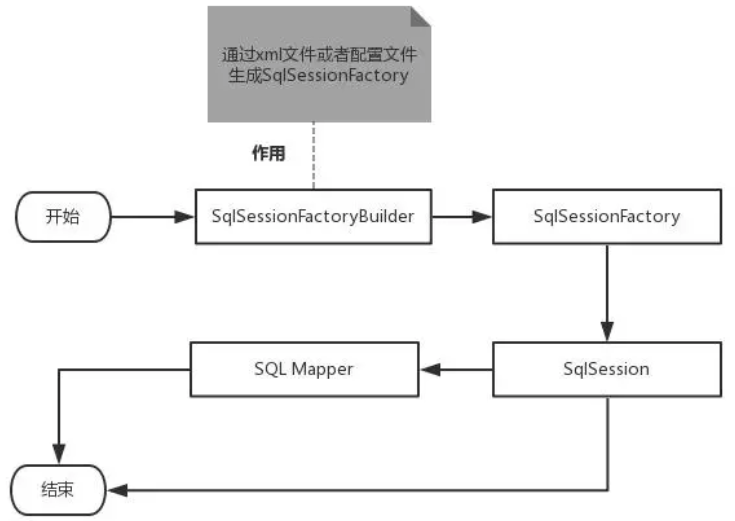
生命周期和作用域是至关重要的,因为错误的使用会导致非常严重的「并发问题」。
SqlSessionFactoryBuilder:
- 一旦创建了 SqlSessionFactory,就不再需要它了(局部变量)
SqlSessionFactory:
- 说白了就是可以想象为:数据库连接池
- 一旦创建就一直存在。其最佳作用域是应用作用域 —— 程序开始即创建,结束才释放。
- 最简单的就是使用「单例模式」或者「静态单例模式」。
SqlSession:
- 连接到连接池的一个请求
- 实例不是线程安全的,不能共享。用完之后需要赶紧关闭,否则资源被占用
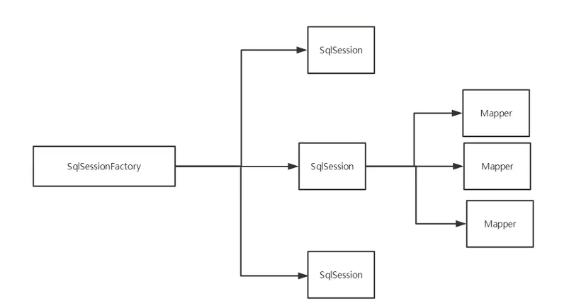
如上图,这里的每一个 mapper,都代表一个具体的业务。
解决属性名和字段名不一致的问题
数据库中的字段:
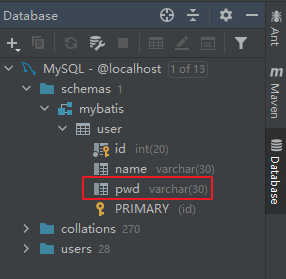
实体类的属性名:

测试出现问题:
User{id=1, name='hhh', password='null'}
User{id=2, name='张三', password='null'}
User{id=3, name='李四', password='null'}
User{id=4, name='王五', password='null'}
User{id=5, name='李五', password='null'}
解决方法:取别名
<!--当实体类的变量名和数据库的字段名不一致时,通过取别名进行更正-->
<select id="getUserList" resulttype="User">
select id, name, pwd as password from mybatis.user
</select>
resultMap
另外的解决方法:结果集映射
id name pwd
id name password
<!--结果集映射:将 UserMap 映射为 User-->
<resultmap id="UserMap" type="User">
<!--column:数据库中的字段,property:实体类中的属性-->
<result column="id" property="id">
<result column="name" property="name">
<result column="pwd" property="password">
</result></result></result></resultmap>
<select id="getUserList" resultmap="UserMap">
select * from mybatis.user
</select>
-
resultMap 元素是 Mybatis 中最重要最强大的元素
-
ResultMap 的设计思想是,对简单的语句做到零配置,对于复杂一点的语句,只需要描述语句之间的关系就行了。
-
ResultMap 的优秀之处,完全可以不用显式地配置相同的字段和属性
<resultmap id="UserMap" type="User"> <!--column:数据库中的字段,property:实体类中的属性--> <result column="pwd" property="password"> </result></resultmap>
日志
日志工厂
如果一个数据库操作出现了异常,我们需要排错,日志是最好的助手。
- LOG4J
- STDOUT_LOGGING
在 mybatis 中具体使用哪一个日志实现,在设置中设定。
在 mybatis 核心配置文件中,配置我们的日志:
<settings>
<setting name="logImpl" value="STDOUT_LOGGING">
</setting></settings>
STDOUT_LOGGING 标准日志输出:
Logging initialized using 'class org.apache.ibatis.logging.stdout.StdOutImpl' adapter.
PooledDataSource forcefully closed/removed all connections.
PooledDataSource forcefully closed/removed all connections.
PooledDataSource forcefully closed/removed all connections.
PooledDataSource forcefully closed/removed all connections.
Opening JDBC Connection
Created connection 641853239.
Setting autocommit to false on JDBC Connection [com.mysql.jdbc.JDBC4Connection@2641e737]
==> Preparing: select * from user where id = ?
==> Parameters: 1(Integer)
<== Columns: id, name, pwd
<== Row: 1, hhh, 123456
<== Total: 1
查询结果:User{id=1, name='hhh', password='123456'}
Resetting autocommit to true on JDBC Connection [com.mysql.jdbc.JDBC4Connection@2641e737]
Closing JDBC Connection [com.mysql.jdbc.JDBC4Connection@2641e737]
Returned connection 641853239 to pool.
Log4j
什么是 log4j?
- Log4j是Apache的一个开源项目,通过使用Log4j,我们可以控制日志信息输送的目的地是控制台、文件、GUI组件。
- 可以控制每一条日志的输出格式
- 通过定义每一条日志信息的级别,我们能够更加细致地控制日志的生成过程
- 可以通过一个配置文件来灵活地进行配置,而不需要修改应用的代码。
配置步骤:
-
先导入 log4j 包
<!-- https://mvnrepository.com/artifact/log4j/log4j --> <dependency> <groupid>log4j</groupid> <artifactid>log4j</artifactid> <version>1.2.17</version> </dependency> -
log4j.properties
# 将等级为 DEBUG 的日志信息输出到 console 和 file 这两个目的地,console 和 file 的定义在下面的代码 log4j.rootLogger = DEBUG, console, file # 控制台输出的相关设置 log4j.appender.console = org.apache.log4j.ConsoleAppender log4j.appender.console.Target = System.out log4j.appender.console.Threshold = DEBUG log4j.appender.console.layout = org.apache.log4j.PatternLayout log4j.appender.console.layout.ConversionPattern = [%c]-%m%n # 文件输出的相关设置 log4j.appender.file = org.apache.log4j.RollingFileAppender log4j.appender.file.File =./log/mybatis.log log4j.appender.file.MaxFileSize = 10mb log4j.appender.file.Threshold = DEBUG log4j.appender.file.layout = org.apache.log4j.PatternLayout log4j.appender.file.layout.ConversionPattern = [%p][%d{yy-MM-dd}][%c]%m%n # 日志输出级别 log4j.logger.org.mybatis = DEBUG log4j.logger.java.sql = DEBUG log4j.logger.java.sql.Statement = DEBUG log4j.logger.java.sql.ResultSet = DEBUG log4j.logger.java.sql.PreparedStatement = DEBUG -
配置 log4j 为日志的实现
<settings> <setting name="logImpl" value="log4j"> </setting></settings> -
log4j 的输出:
[org.apache.ibatis.logging.LogFactory]-Logging initialized using 'class org.apache.ibatis.logging.log4j.Log4jImpl' adapter. [org.apache.ibatis.logging.LogFactory]-Logging initialized using 'class org.apache.ibatis.logging.log4j.Log4jImpl' adapter. [org.apache.ibatis.datasource.pooled.PooledDataSource]-PooledDataSource forcefully closed/removed all connections. [org.apache.ibatis.datasource.pooled.PooledDataSource]-PooledDataSource forcefully closed/removed all connections. [org.apache.ibatis.datasource.pooled.PooledDataSource]-PooledDataSource forcefully closed/removed all connections. [org.apache.ibatis.datasource.pooled.PooledDataSource]-PooledDataSource forcefully closed/removed all connections. [org.apache.ibatis.transaction.jdbc.JdbcTransaction]-Opening JDBC Connection [org.apache.ibatis.datasource.pooled.PooledDataSource]-Created connection 302155142. [org.apache.ibatis.transaction.jdbc.JdbcTransaction]-Setting autocommit to false on JDBC Connection [com.mysql.jdbc.JDBC4Connection@12028586] [org.example.dao.UserMapper.getUserById]-==> Preparing: select * from user where id = ? [org.example.dao.UserMapper.getUserById]-==> Parameters: 1(Integer) [org.example.dao.UserMapper.getUserById]-<== Total: 1 查询结果:User{id=1, name='hhh', password='123456'} [org.apache.ibatis.transaction.jdbc.JdbcTransaction]-Resetting autocommit to true on JDBC Connection [com.mysql.jdbc.JDBC4Connection@12028586] [org.apache.ibatis.transaction.jdbc.JdbcTransaction]-Closing JDBC Connection [com.mysql.jdbc.JDBC4Connection@12028586] [org.apache.ibatis.datasource.pooled.PooledDataSource]-Returned connection 302155142 to pool.
简单使用
-
在要使用 Log4j 的类中导入包(
import org.apache.log4j.Logger;) -
日志对象,参数为当前类的 class
static Logger logger = Logger.getLogger(UserMapperTest.class); -
日志级别
logger.info("info:进入了 log4jTest() ......"); logger.debug("debug:进入了 log4jTest() ......"); logger.error("error:进入了 log4jTest() ......");
分页
为什么需要分页?分页可以减少数据的处理量。
使用 Limit 实现分页
select * from user limit 3; # [0, 3]
使用 Mybatis 实现分页,核心 SQL
-
接口:
// 分页查询 List<user> getUserByLimit(Map<string, integer=""> map); -
UserMapper.xml
<!--分页查询--> <select id="getUserByLimit" parametertype="map" resultmap="UserMap"> select * from user limit #{startIndex}, #{pageSize} </select> -
测试
@Test public void getUserByLimitTest() { SqlSession sqlSession = MybatisUtils.getSqlSession(); UserMapper mapper = sqlSession.getMapper(UserMapper.class); Map<string, integer=""> map = new HashMap<string, integer="">(); map.put("startIndex", 0); map.put("pageSize", 2); List<user> userList = mapper.getUserByLimit(map); for (User user : userList) { System.out.println(user); } sqlSession.close(); }
RowBounds 分页
不再使用 SQL 语句分页
-
接口
// 分页查询:RowBounds List<user> getUserByRowBounds(); -
UserMapper.xml
<!--分页查询:RowBounds--> <select id="getUserByRowBounds" parametertype="map" resultmap="UserMap"> select * from user </select> -
测试
@Test public void getUserByRowBoundsTest() { SqlSession sqlSession = MybatisUtils.getSqlSession(); // RowBounds 实现 RowBounds rowBounds = new RowBounds(1, 2); // 通过 Java 代码层面实现分页 List<user> userList = sqlSession.selectList("org.example.dao.UserMapper.getUserByRowBounds", null, rowBounds); for (User user : userList) { System.out.println(user); } sqlSession.close(); }
分页插件:Mybatis PageHelper
了解即可
使用注解开发
面向接口编程
在真正的开发中,很多时候我们会选择面向接口编程
根本原因 : 解耦 , 可拓展 , 提高复用 , 分层开发中 , 上层不用管具体的实现 , 大家都遵守共同的标准 , 使得开发变得容易 , 规范性更好
- 在一个面向对象的系统中,系统的各种功能是由许许多多的不同对象协作完成的。在这种情况下,各个对象内部是如何实现自己的,对系统设计人员来讲就不那么重要了;
- 而各个对象之间的协作关系则成为系统设计的关键。小到不同类之间的通信,大到各模块之间的交互,在系统设计之初都是要着重考虑的,这也是系统设计的主要工作内容。面向接口编程就是指按照这种思想来编程。
关于接口的理解:
-
接口从更深层次的理解,应是定义(规范,约束)与实现(名实分离的原则)的分离。
-
接口的本身反映了系统设计人员对系统的抽象理解。
-
接口应有两类:
-
- 第一类是对一个个体的抽象,它可对应为一个抽象体(abstract class);
- 第二类是对一个个体某一方面的抽象,即形成一个抽象面(interface);
-
一个体有可能有多个抽象面。抽象体与抽象面是有区别的。
三个面向区别:
- 面向对象是指,我们考虑问题时,以对象为单位,考虑它的属性及方法 ;
- 面向过程是指,我们考虑问题时,以一个具体的流程(事务过程)为单位,考虑它的实现 ;
- 接口设计与非接口设计是针对复用技术而言的,与面向对象(过程)不是一个问题,更多的体现就是对系统整体的架构
使用注解开发
-
注解在接口上实现
@Select("select * from user") List<user> getUsers(); -
需要在核心配置文件中绑定接口
<!--绑定接口--> <mappers> <mapper class="org.example.dao.UserMapper"> </mapper></mappers> -
测试
@Test public void test() { SqlSession sqlSession = MybatisUtils.getSqlSession(); // 底层主要应用反射 UserMapper mapper = sqlSession.getMapper(UserMapper.class); List<user> users = mapper.getUsers(); for (User user : users) { System.out.println(user); } sqlSession.close(); }
本质:反射机制实现
底层:动态代理
Mybatis 详细的执行流程:
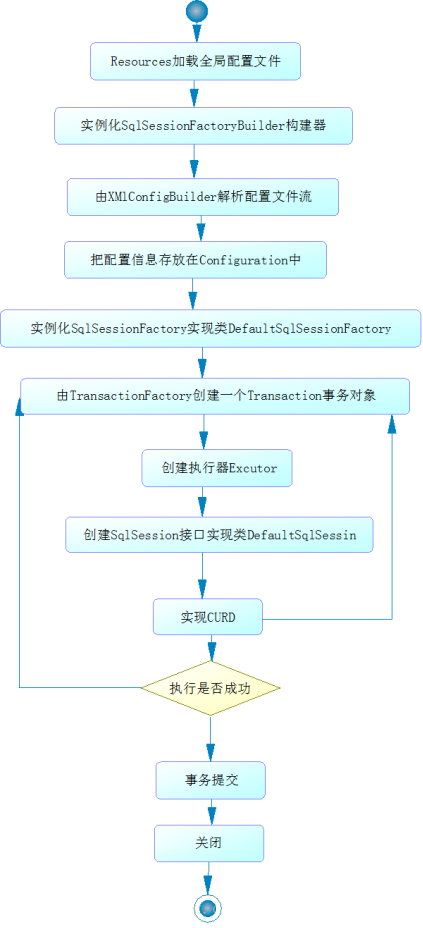
CRUD
可以在工具类创建的时候实现自动提交事务:
public static SqlSession getSqlSession() {
return sqlSessionFactory.openSession(true); // true:自动提交事务
}
编写接口,增加注解:
public interface UserMapper {
@Select("select * from user")
List<user> getUsers();
// 方法存在多个参数,参数前面需要加入 @Param 注解,一个参数可写可不写
@Select("select * from user where id = #{id}")
User getUserById(@Param("id") int id);
@Insert("insert into user(id, name, pwd) values (#{id}, #{name}, #{password})")
int addUser(User user);
@Update("update user set name = #{name}, pwd = #{password} where id = #{id}")
int updateUser(User user);
@Delete("delete from user where id = #{uid}")
int deleteUser(@Param("uid") int id);
}
注意:我们必须要将接口注册绑定到我们的核心配置文件中
关于 @Param() 注解
-
基本类型的参数或 String 类型,需要加上
-
引用类型不需要加
-
如果只有一个基本类型的话,可以不加,但是建议加上
-
在 SQL 中引用的就是 @Param() 设定的属性名
Lombok
使用步骤:
-
在 IDEA 中安装 Lombok 插件
-
在项目中导入 lombok 的 jar 包
<!-- https://mvnrepository.com/artifact/org.projectlombok/lombok --> <dependency> <groupid>org.projectlombok</groupid> <artifactid>lombok</artifactid> <version>1.18.20</version> </dependency> -
在实体类上加注解。
@Data @AllArgsConstructor @NoArgsConstructor更多有关注解如下:
@Getter and @Setter @FieldNameConstants @ToString @EqualsAndHashCode @AllArgsConstructor, @RequiredArgsConstructor and @NoArgsConstructor @Log, @Log4j, @Log4j2, @Slf4j, @XSlf4j, @CommonsLog, @JBossLog, @Flogger, @CustomLog @Data @Builder @SuperBuilder @Singular @Delegate @Value @Accessors @Wither @With @SneakyThrows
多对一处理
● 例子:多个学生对应一个老师
建表:
CREATE TABLE `teacher` (
`id` INT(10) NOT NULL,
`name` VARCHAR(30) DEFAULT NULL,
PRIMARY KEY (`id`)
) ENGINE=INNODB DEFAULT CHARSET=utf8;
INSERT INTO teacher(`id`, `name`) VALUES (1, "黄老师");
CREATE TABLE `student` (
`id` INT(10) NOT NULL,
`name` VARCHAR(30) DEFAULT NULL,
`tid` INT(10) DEFAULT NULL,
PRIMARY KEY (`id`),
KEY `fktid` (`tid`),
CONSTRAINT `fktid` FOREIGN KEY (`tid`) REFERENCES `teacher` (`id`)
) ENGINE=INNODB DEFAULT CHARSET=utf8;
INSERT INTO `student` (`id`, `name`, `tid`) VALUES (1, "小明", 1);
INSERT INTO `student` (`id`, `name`, `tid`) VALUES (2, "小红", 1);
INSERT INTO `student` (`id`, `name`, `tid`) VALUES (3, "小张", 1);
INSERT INTO `student` (`id`, `name`, `tid`) VALUES (4, "小李", 1);
INSERT INTO `student` (`id`, `name`, `tid`) VALUES (5, "小王", 1);
测试环境搭建
- 导入 lombok
- 新建实体类 Teacher,Student
- 创建 Mapper 接口
- 创建 Mapper.xml 文件
- 在核心配置文件中绑定注册我们的 Mapper 接口或文件
- 测试
按照查询嵌套处理
<mapper namespace="org.example.dao.StudentMapper">
<!--复杂查询思路:
1.查询所有学生的信息
2.根据查询出来的学生的 tid 寻找对应的老师
-->
<select id="getStudent" resultmap="StudentTeacher">
select * from student;
</select>
<resultmap id="StudentTeacher" type="Student">
<result property="id" column="id">
<result property="name" column="name">
<!--复杂的属性,我们需要单独处理
对象:使用 association
集合:使用 collection
-->
<association property="teacher" column="tid" javatype="Teacher" select="getTeacher">
</association></result></result></resultmap>
<select id="getTeacher" resulttype="Teacher">
select * from teacher where id = #{id}
</select>
</mapper>
按照结果嵌套处理
<!--按照结果嵌套处理-->
<select id="getStudent2" resultmap="StudentTeacher2">
select s.id sid, s.name sname, t.name tname
from student s, teacher t
where s.tid = t.id;
</select>
<resultmap id="StudentTeacher2" type="Student">
<result property="id" column="sid">
<result property="name" column="sname">
<association property="teacher" javatype="Teacher"> <!--关联老师-->
<result property="name" column="tname">
</result></association>
</result></result></resultmap>
回顾 Mysql 多对一查询方式:
- 子查询
- 联表查询
一对多处理
● 例子:一个学生有多个任课老师
搭建环境:
实体类:
@Data // 使用了 lombok 插件
public class Student {
private int id;
private String name;
private int tid;
}
@Data // 使用了 lombok 插件
public class Teacher {
private int id;
private String name;
private List<student> students; // 一个老师教多个学生
}
按照结果嵌套处理
<select id="getTeacher" resulttype="Teacher">
select * from teacher;
</select>
<!--按结果嵌套查询-->
<select id="getTeacher2" resultmap="TeacherStudent">
select s.id sid, s.name sname, t.name tname, t.id tid
from student s, teacher t
where s.tid = t.id and t.id = #{tid};
</select>
<resultmap id="TeacherStudent" type="Teacher">
<result property="id" column="tid">
<result property="name" column="tname">
<!--复杂的属性,我们需要单独处理
对象:使用 association
集合:使用 collection
javaType:指定的属性类型,集合中的泛型信息,我们使用 ofType 获取
-->
<collection property="students" oftype="Student">
<result property="id" column="sid">
<result property="name" column="sname">
<result property="tid" column="tid">
</result></result></result></collection>
</result></result></resultmap>
按照查询嵌套处理
<select id="getTeacher3" resultmap="TeacherStudent3">
select * from teacher where id = #{tid};
</select>
<resultmap id="TeacherStudent3" type="Teacher">
<collection property="students" javatype="ArrayList" oftype="Student" select="getStudentByTeacherId" column="id">
<result property="id" column="id">
<result property="name" column="name">
<result property="tid" column="tid">
</result></result></result></collection>
</resultmap>
<select id="getStudentByTeacherId" resulttype="Student">
select * from student where tid = #{tid};
</select>
小结
● 关联 - associate 多对一
● 集合 - collection 一对多
● javaType & ofType
- javaType 用来指定实体类中属性的类型
- ofType 用来指定映射到 List 或者集合中的 pojo 类型,泛型中的约束类型
注意点:
- 保证 SQL 的可读性,尽量保证通俗易懂
- 注意一对多和多对一中,属性名和字段的问题
- 如果问题不好排查错误,可以使用日志,建议使用 log4j
高频问题:
- MySQL 引擎
- InnoDB 底层原理
- 索引
- 索引优化
动态 SQL
什么是动态 SQL?
动态 SQL 就是指根据不同的条件生成不同的 SQL 语句。所谓的动态 SQL,本质还是 SQL 语句,只是我们可以在 SQL 层面,去执行一些逻辑代码。
搭建环境
新建一个数据库表 —— blog:
CREATE TABLE `blog` (
`id` varchar(50) NOT NULL COMMENT '博客id',
`title` varchar(100) NOT NULL COMMENT '博客标题',
`author` varchar(30) NOT NULL COMMENT '博客作者',
`create_time` datetime NOT NULL COMMENT '创建时间',
`views` int(30) NOT NULL COMMENT '浏览量'
) ENGINE=InnoDB DEFAULT CHARSET=utf8;
创建一个基础工程:
-
导包
-
编写配置文件
-
编写实体类
@Data public class Blog { private int id; private String title; private String author; private Date createTime; private int views; } -
编写实体类对应的 Mapper 接口和 Mapper.xml 文件
IF
// IF 查询
List<blog> queryBlogWithIf(Map map);
<!--IF 查询-->
<select id="queryBlogWithIf" parametertype="map" resulttype="blog">
select * from blog
and title = #{title}
and author = #{author};
</select>
trim (where, set)
<!--Choose 查询:只会选择其中一个满足条件的运行-->
<select id="queryBlogWithChoose" parametertype="map" resulttype="blog">
select * from blog
title = #{title}
and author = #{author}
and views = #{views}
</select>
<!--set 标签会动态前置 SET 关键字,同时也会删除无关的逗号-->
<update id="updateBlog" parametertype="map">
update blog
<set>
<if test="title != null">
title = #{title},
</if>
<if test="author != null">
author = #{author}
</if>
</set>
where id = #{id}
</update>
所谓的动态 SQL,本质还是 SQL 语句,只是我们可以在 SQL 层面,去执行一些逻辑代码。
if
where,set,choose,when
Foreach
需求:我们需要查询 blog 表中 id 分别为 1,2,3 的博客信息
<!--select * from blog where 1=1 and (id=1 or id=2 or id=3)
我们现在传递一个万能的 map,这个 map 中可以存在一个集合
collection:指定输入对象中的集合属性
item:每次遍历生成的对象
open:开始遍历时的拼接字符串
close:结束时拼接的字符串
separator:遍历对象之间需要拼接的字符串
-->
<select id="queryBlogWithForeach" parametertype="map" resulttype="blog">
select * from blog
id = #{id}
</select>
SQL 片段
有的时候,我们可能会将一些功能抽取出来,方便复用。
-
使用 SQL 标签抽取公共部分
<sql id="if-title-author"> <if test="title != null"> and title = #{title} </if> <if test="author != null"> and author = #{author} </if> </sql> -
在需要使用的地方使用 include 标签引用即可
<select id="queryBlogWithIf" parametertype="map" resulttype="blog"> select * from blog </select>
注意事项:
- 最好基于单表来定义 SQL 片段
- 不要存在 where 标签
动态 SQL 就是在拼接 SQL 语句,我们只要保证 SQL 的正确性,按照 SQL 的格式,去排列组合就可以了!
建议:先在 MySQL 中写出完整的 SQL,然后再通过 mybatis 动态 sql 对照着改,防止出错。
缓存
简介
1、什么是缓存(Cache)?
- 存在内存中的临时数据。
- 将用户经常查询的数据放在缓存(内存)中,用户去查询数据就不用从磁盘上(关系型数据库数据文件)查询,从缓存中查询,从而提高查询效率,解决了高并发系统的性能问题。
2、为什么使用缓存?
-
查询连接数据库,耗费资源
-
缓存可以减少和数据库的交互次数,减少系统开销,提高系统效率。
3、什么样的数据能使用缓存?
- 经常查询并且不经常改变的数据。
Mybatis缓存
MyBatis包含一个非常强大的查询缓存特性,它可以非常方便地定制和配置缓存。缓存可以极大的提升查询效率。
MyBatis系统中默认定义了两级缓存:一级缓存和二级缓存
- 默认情况下,只有一级缓存开启。(SqlSession 级别的缓存,也称为本地缓存)
- 二级缓存需要手动开启和配置,他是基于 namespace 级别的缓存。
- 为了提高扩展性,MyBatis 定义了缓存接口 Cache。我们可以通过实现 Cache 接口来自定义二级缓存
一级缓存
一级缓存也叫本地缓存:
- 与数据库同一次会话期间查询到的数据会放在本地缓存中。
- 以后如果需要获取相同的数据,直接从缓存中拿,没必须再去查询数据库;
测试步骤:
- 开启日志
- 测试在一个 SqlSession 中查询两次相同的记录
- 查看日志输出
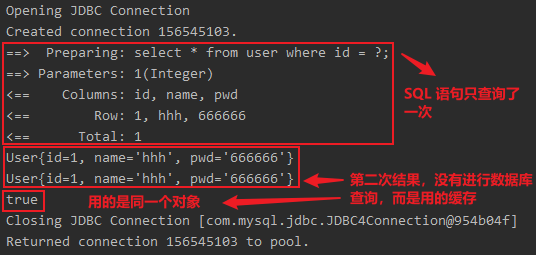
缓存失效的情况:
-
查询不同的条目
-
增删改操作,可能会改变原来的数据,所以必定会刷新缓存,导致缓存失效
-
查询不同的 Mapper.xml
-
手动清理缓存
@Test public void getUserByIdTest() { SqlSession sqlSession = MybatisUtils.getSqlSession(); UserMapper mapper = sqlSession.getMapper(UserMapper.class); User user = mapper.getUserById(1); System.out.println(user); sqlSession.clearCache(); // 手动清理缓存 User user2 = mapper.getUserById(1); System.out.println(user2); System.out.println(user==user2); sqlSession.close(); }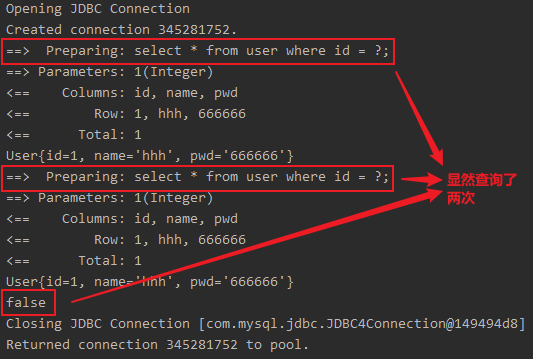
小结:一次缓存是默认开启的,只在一次 SqlSession 中有效,也就是从「开启连接」到「关闭连接」这个区间段。
一级缓存相当于一个 Map。
二级缓存
二级缓存也叫全局缓存,一级缓存作用域太低了,所以诞生了二级缓存;
基于 namespace 级别的缓存,一个名称空间,对应一个二级缓存;
工作机制:
- 一个会话查询一条数据,这个数据就会被放在当前会话的一级缓存中;
- 如果当前会话关闭了,这个会话对应的一级缓存就没了;但是我们想要的是,会话关闭了,一级缓存中的数据被保存到二级缓存中;
- 新的会话查询信息,就可以从二级缓存中获取内容;
- 不同的 mapper 查出的数据会放在自己对应的缓存(map)中;
设置:
-
开启全局缓存
mybatis-config.xml 核心配置文件中:
```xml <!--显式开启 cache 缓存--> <setting name="cacheEnabled" value="true"> ``` -
在要使用二级缓存的 Mapper 中开启
Mapper.xml 文件中:
<!--在当前的 Mapper.xml 文件中使用二级缓存--> <cache>也可以自定义一些参数:
<!--在当前的 Mapper.xml 文件中使用二级缓存--> <cache eviction="FIFO" flushinterval="60000" size="512" readonly="true"> -
测试
@Test public void cacheTest() { SqlSession sqlSession = MybatisUtils.getSqlSession(); SqlSession sqlSession2 = MybatisUtils.getSqlSession(); UserMapper mapper = sqlSession.getMapper(UserMapper.class); User user = mapper.getUserById(1); System.out.println(user); sqlSession.close(); UserMapper mapper2 = sqlSession2.getMapper(UserMapper.class); User user2 = mapper2.getUserById(1); System.out.println(user2); sqlSession2.close(); }测试时出现的问题:
-
没有序列化接口:
org.apache.ibatis.cache.CacheException: Error serializing object. Cause: java.io.NotSerializableException: org.example.pojo.User -
解决方法:
public class User implements Serializable,加入了implements Serializable
-
小结:
- 只要开启了二级缓存,我们在同一个 Mapper 中查询,可以在二级缓存中拿到数据
- 所有的数据都会先放在一级缓存中
- 只有当会话提交,或者关闭的时候,才会提交到二级缓存中
缓存原理
缓存顺序:
- 先看二级缓存中有没有想要的数据
- 再看一级缓存中有没有想要的数据
- 都没有则查询数据库
示意图:
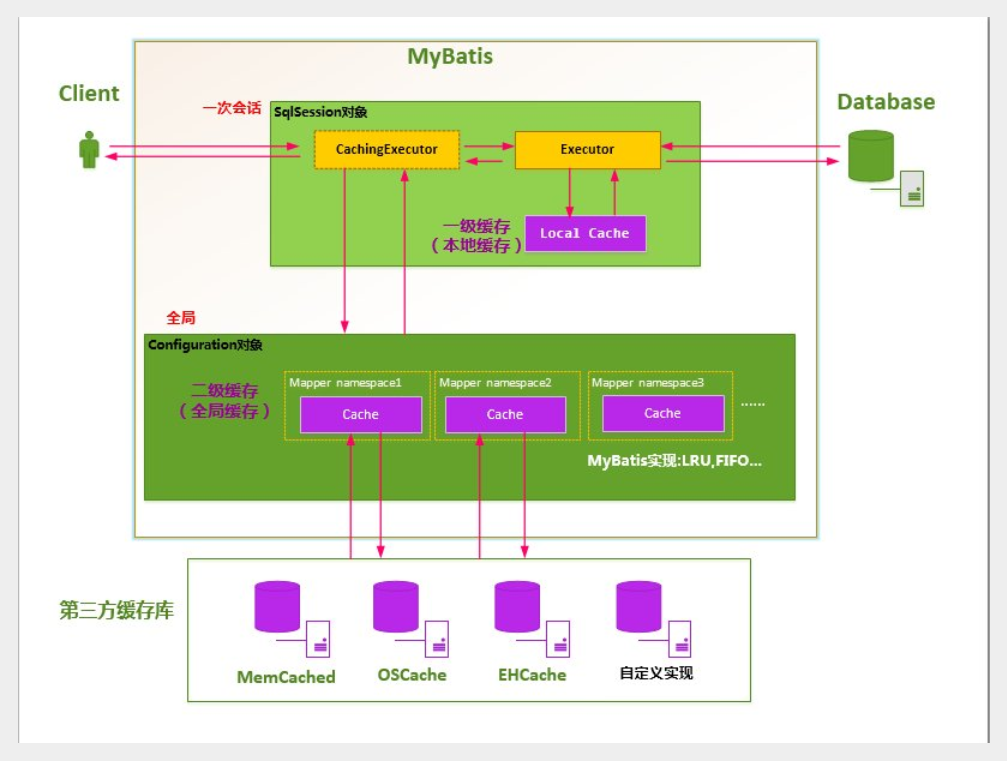
= = = = = = = = = = = = = = = = = THE END = = = = = = = = = = = = = = = = = = = = = </string,></string,></string,></string,></string,></string,></https:></https:></https:>




